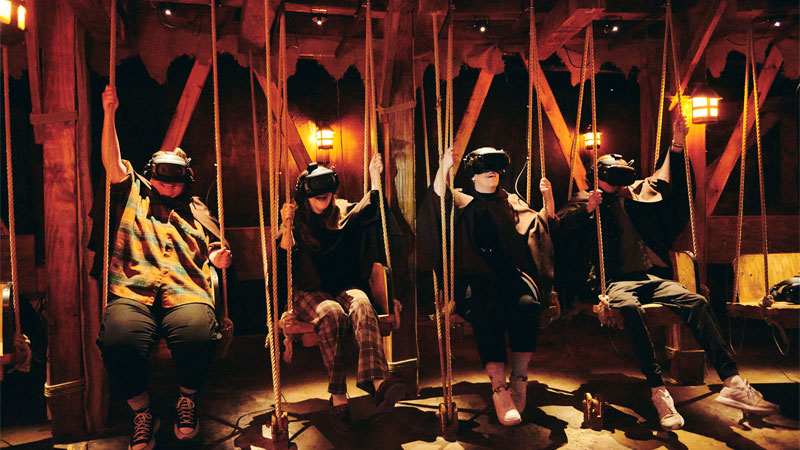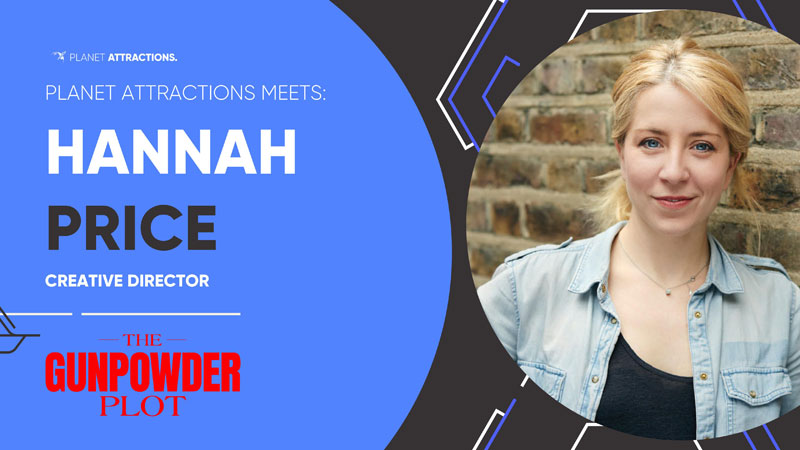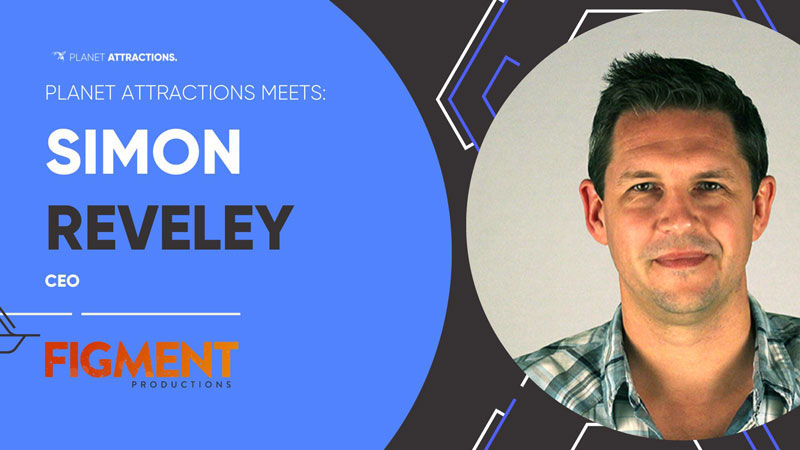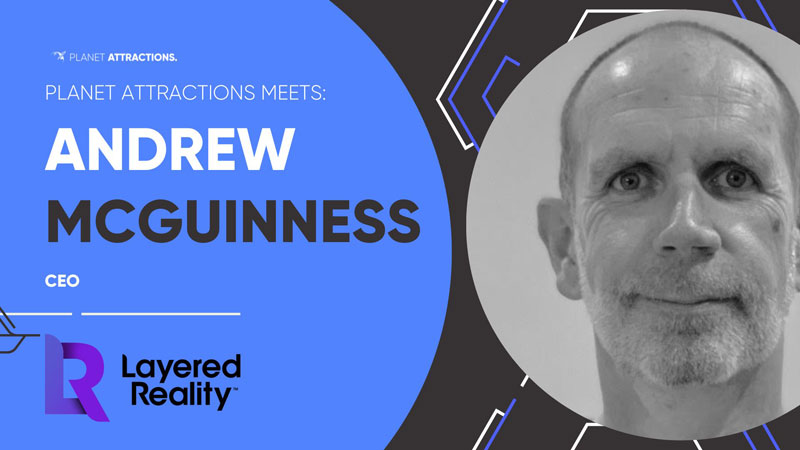|
The Gunpowder Plot is a multilayered immersive experience set at the Tower of London. Planet Attractions spoke to the team behind the development to see exactly how it came to life...

Tom Anstey | Planet Attractions | 10 Aug 2023

 The Gunpowder Plot utilises a combination of live actors, immersive sets, virtual reality and multi-sensory effects to create a one-of-a-kind offering Credit: Layered Reality The Gunpowder Plot utilises a combination of live actors, immersive sets, virtual reality and multi-sensory effects to create a one-of-a-kind offering Credit: Layered Reality
A new immersive experience that arrived in London in May 2022 and stars Harry Potter actor Tom Felton has been turning a lot of heads.
Located in the Tower of London’s Tower Vaults,’The Gunpowder Plot’ is a ‘cloak and dagger’ experience that brings visitors into the heart of the story of the famously failed attempt by Roman Catholics to blow up King James I and the Houses of Parliament on November 5 1605.
A multi-million pound permanent attraction, immersive experience company Layered Reality has worked alongside Historic Royal Palaces, and VR specialists Figment Productions to make audiences feel as though they are part of the failed gunpowder plot led by the infamous Guy Fawkes and played by Felton.
In the experience, guests encounter a mix of live actors, immersive sets, virtual reality and multi-sensory effects to create something that is unique in its presentation.
Lasting just under two hours, guests start inside a cell in the Tower of London, where live actors perform the Gunpowder Plot story, leading them though 24 interactive scenes that bring them into the action, even at one point having to hide themselves from a group of Protestants seeking them out as they attempt to escape the Tower.
The experience also features two bars, one of which is set in 1605 halfway through the experience and where guests decide to support the plotters or betray them to the crown.
Putting together such an experience required a number of creative minds. Offering a wealth of experience in theatre and videogame direction, Hannah Price created the story and experience for The Gunpowder Plot. Meanwhile, Simon Reveley heads up the award winning Figment Productions, who are responsible for the VR and technical effects in the experience. Finally, Andrew McGuinness is the founder of Layered Reality, the company that brought the whole project together and has also created the popular Jeff Waynes’s The War of the Worlds: The Immersive Experience, which is the longest-running immersive experience in the British capital.
Working alongside a full team, Price, Reveley and McGuinness, worked together to create The Gunpowder Plot. Planet Attractions spoke to the trio to hear their thoughts on the creation of the attraction, the end result and more.

What is your role with Layered Reality?
“I’m a freelance creative director who was brought into Layered Reality to work on The Gunpowder Plot.
Layered Reality is a brilliant creative company, and while I am not there full time, I am always in and out, developing ideas and catching up with the team, who are fantastic.”
What was the development of The Gunpowder Plot like?
“Developing The Gunpowder Plot was like standing on a hurtling train and having the best time while you do it.
I was lucky enough to work with such a brilliant team, across creative, stage management, ops and tech. We worked closely with the Tower to research the project, which added a really exciting geeky element for me: I love history and getting to go for meetings in the Tower of London was a highlight. We even got invited to the Beefeaters pub.
I think the thing I’m most proud of is the quality of the writing, thanks to Danny Robins, and the acting thanks to the amazing cast and the on-site directors.”
Can you explain the visitor journey through the attraction?
“Visiting the Gunpowder Plot is like stepping into a movie of the story with you as the hero or anti-hero.
You are surrounded by the sights, smells, sounds, and even temperatures of Jacobean London and the world of the story. You get to meet and befriend those at the heart of the plot, and make a very important decision that changes the story, and indeed, could change the course of history.”
How important was the location for this?
“The location was super important to the storytelling.
On a practical level it’s a listed building, on the estate of a Unesco World Heritage Site. We needed to be careful!
The low ceilings create a certain feeling, the winding walls that we couldn’t change the shape of. We didn’t think that outdoor locations were going to work inside the building for example, and quickly made the decision that outdoor scenes would be achieved in VR or digitally.
The space felt dark and full of intrigue, which greatly affected even which story we chose to tell. It’s like another character in the show - one that gave us a lot of inspiration and shortcuts for exposition, but also one that caused its own difficulties.”
How was Tom Felton to work with?
“Tom is amazing. I can’t tell you what an extraordinary talent he is.
We wanted someone who could embody a character that is so complex: is he a hero? Is he something much darker? Tom exceeded all my expectations and worked so hard. We had him with his arms chained (for the torture scene) and we kept saying to him ‘do you need a break?’ He just wanted to work and get it right. I was so moved watching him perform his scenes: we wanted to embody both the charisma and fanaticism of Guy Fawkes, and he brought that so beautifully to life.”
You have a background including theatre and video games, what kind of things are they and how did those skills compliment this project?
“My background is in theatre, I trained at RADA and at the Donmar Warehouse and have been lucky enough to direct all over the world.
For video games I direct the performance of the actors, and work on the story. It’s the story that binds all my work together: through both mediums I understand the bones of a story and how to build tension.
Games add an element of technology that I adore, and theatre forces you to think psychologically about the depth of a story. Immersive storytelling is a wonderful hybrid of all this, where you have the freedom to ask: what story am I trying to tell? What medium would best allow me to tell it?
Layered Reality’s approach is also about building the layers of an experience, so when you are creating a scene you think about it in 3D: everything from the air flow and how humid it might be to the floor texture and the nuance of an actor's performance.
All of these things must come together for it to work. It’s still human connection that is the holy grail: how do you make your audience feel deeply about these characters in front of them? When we do that well in immersive, theatre or games it’s complete magic.”
How did you incorporate elements, such as VR into the story?
“We worked hard with the tech teams and the VR studio (Figment) to try to make the VR feel like it belonged. I mentioned above that we made a decision early on to have outdoor vistas in VR: we made sure we chose story moments that were best served by VR as a medium. We made the decision that these were also moments of travel: where the story needed us to move location or, indeed, time. When we had these rules in place we then worked to make sure the VR worlds and our real life world complimented and built on each other.
Our brilliant designer Tim McQuillen-Wright would swap renders with the VR team and vice versa to match environments. We have a brilliant trick where you go into VR in a set that matches the digital world you are entering. That world changes in VR. Tim designed it so while you have your headset on we switch the set so when you take your headset off, you feel like you’ve moved location. It’s simple but brilliant.
Lastly we made reasons for putting on the ‘headset’ and refer to it as a mask so there were no icky moments where someone in 1605 had to say the word ‘headset’ or pretend to not know what it was.”
What kind of direction do live actors get in the attraction?
“The actors get a lot of direction. Our original cast worked with us in a way that followed the more traditional rehearsal processes, starting with table work, moving into blocking and getting the scenes on their feet. They were amazing and helped originate the shape of the scenes as they are now.
Our in-house team then directs each new cast member as they come - the experience has been running for over a year so we have new casts come in when other actors finish their contracts.
The in-house team is fantastic. We focus very much on making sure the actors are grounded in the nuance and difficulty of the time, but also have the space to build a strong empathetic character of their own. Actors are amazing, and we want them to bring their own thoughts and expertise, so no two renditions are the same, though the overall shape of the scenes might be.”
How important is immersion when it comes to attractions?
“I really love what Andrew McGuinness says about this: it’s about memory making.
I read a study recently that shows that very immersive environments, whatever they might be, help the brain make millions of new connections, which in turn changes the actual structure of the brain. So essentially come to one of our immersive experiences and have your mind literally blown.
In all seriousness the immersive sector is expanding and new incredible attractions made by extremely brilliant people are arriving everyday. So for me immersion is important because it’s breaking new frontiers, bringing new audiences and expanding my brain and hopefully everyone else’s.”
How does it feel seeing the overall experience when it all comes together with tech, actors and immersive environments?
“When an experience comes together it’s like pure joy. So many talented people work so hard to bring these experiences together, and when they finally arrive there’s an alchemy that's something like magic. You look at the walls you first saw on a plan two years ago, and hear the words you saw on a script three months ago and smell the dank smell you know comes from a scent machine, but it doesn’t matter. All together at that moment it becomes real.”

What does Figment Productions do in a nutshell?
“Figment is a digital media production studio working primarily in the attractions industry. We cover film, animation, computer graphics and software development.
I founded the business nearly 15 years ago but since 2016, we’ve been best known for our work with immersive tech like projection mapping, virtual reality and other technologies under the banner of ‘XR’.”
How did The Gunpowder Plot come about?
“Figment worked in partnership with The Royal Opera House to create an immersive, short-form opera, called ‘Current, Rising’ which was one of the first public experiences to open in London after the Covid lockdowns were lifted. It won the VR Awards Best Out-of-Home VR Entertainment of the Year in 2021 and attracted a lot of attention.
That was when we connected with the Layered Reality team who were impressed with the technical, operational systems we’d developed, as well as the content work.”
What was your role in the project?
“I was the media producer for The Gunpowder Plot. That covered all visual media, including video projection, and the VR scenes.”
How do you incorporate VR into physical experiences?
“The vast majority of projects we do are delivered into locations (museums, theme parks, visitor attractions - and now immersive theatre shows). So, the physical space and the technical hardware are equally important tools in the toolbox for us, alongside Unreal Engine and the array of software technologies we have at our disposal.
We work really closely with the creative teams on concept development, scripts, set and prop design, and then the technical teams on hardware systems. When you do this kind of work you can’t just hide in your studio and send a link to the output you create; you have to be across the whole production, and you very much have to get your hands dirty on-site: integrating, iterating, testing, tweaking.
We work with motion bases, bespoke electronics, projection mapping, media servers, complex networked multi-user software, smell machines, lighting, and pretty much anything you can imagine. When we do VR, the ultimate aim is that people forget about the headset and lose themselves in the experience. To achieve that, you have to design a multi-layered experience where VR is just one ingredient.”
What kind of technical effects did you produce?
“For The Gunpowder Plot, we created a 360-degree projection mapped room, integrated with smoke, lighting and rumble effects; we created a VR experience with electronics integration to control and respond to custom designed moving seats (I’m trying to avoid plot spoilers here, so keeping my descriptions as generic as possible); we control a series of motion simulators which take groups of guests on a magical journey through the London of 1605; and lots of smaller elements sprinkled throughout the experience.”
How does it feel seeing the overall experience when it all comes together with tech, actors and immersive environments?
“Layered Reality’s name is much more descriptive than people realise. These types of shows are made exponentially more immersive with each layer that you add; from the story to the smells, from the actors to the audience’s role in the plot, from the set-work to the lighting, the sound design and the music.
It’s a cliche to say that something is ‘greater than the sum of the parts’, but with a Layered Reality show, you really are looking at the state-of-the-art in what we currently call immersive theatre. You simply have to experience this stuff yourself to feel the full impact of how it makes you feel when you're transported to another world so completely.”

What is the history of Layered Reality
“I founded the business in 2017 having become excited about the potential of the experience economy.
From day one we set out to offer something different, fusing some of the tools of conventional theatre (intricate sets and first class actors) with technology. The result is that we can take people for an hour or two to another world and provide them with a memorable adventure”
What are some of the most notable experiences you have created?
“We’ve now created three five-star experiences that are ranked in the top 10% of all attractions globally based upon TripAdvisor reviews.
Currently we have The Gunpowder Plot and JW The War of the Worlds open in London with a further show opening early next year. Choosing between them is like asking which is your favourite child!”
How did the Gunpowder Plot come about?
“We began discussions in 2018 with Historic Royal Palaces and after lots of discussion agreed to tell the tale of one of the world’s greatest plots.
It’s an amazing, truly groundbreaking experience allowing guests to step back in time to 1605, allowing people to not just see the history (as they do if they visit the Tower of London) but to be part of it.”
What does having a name like Tom Felton attached mean for the attraction?
“First and foremost Tom is a first class actor who brings his unique talents to bear in the role of Guy Fawkes. He’s also a magnet, helping people who may know him from his Harry Potter role discover the experience.”
What else is Layered Reality working on?
“That would be telling! But there’s a lot in the pipeline…”
What's the feedback on the Gunpowder Plot attraction been like?
“We’ve been blown away! The experiences consistently are the highest rating of all immersive experiences based on customer reviews.
Not only that but we’ve also been recognised by global industry bodies like the Themed Entertainment Association’s THEA Awards, and have received coveted five star reviews from titles like The Times.’
How important is immersion when it comes to attractions?
“It’s an overused word but an undelivered sensation! If you’re truly immersed you leave your everyday world behind for a couple of hours - and we all need that occasionally.
In our experiences the fact that what you’re seeing, feeling and even smelling all reinforces that, for example you’ve travelled back in time, you do become truly immersed.”
How does it feel seeing the overall experience when it all comes together with tech, actors and immersive environments?
“Seamless. You forget that you're in an ‘experience’ and instead lose yourself in the story, becoming a participant in a thrilling adventure. You’ve got to try it.”
Visitor attractions
|
|






Supplier Showcase 2025: The biggest attractions projects landing worldwide this year
|